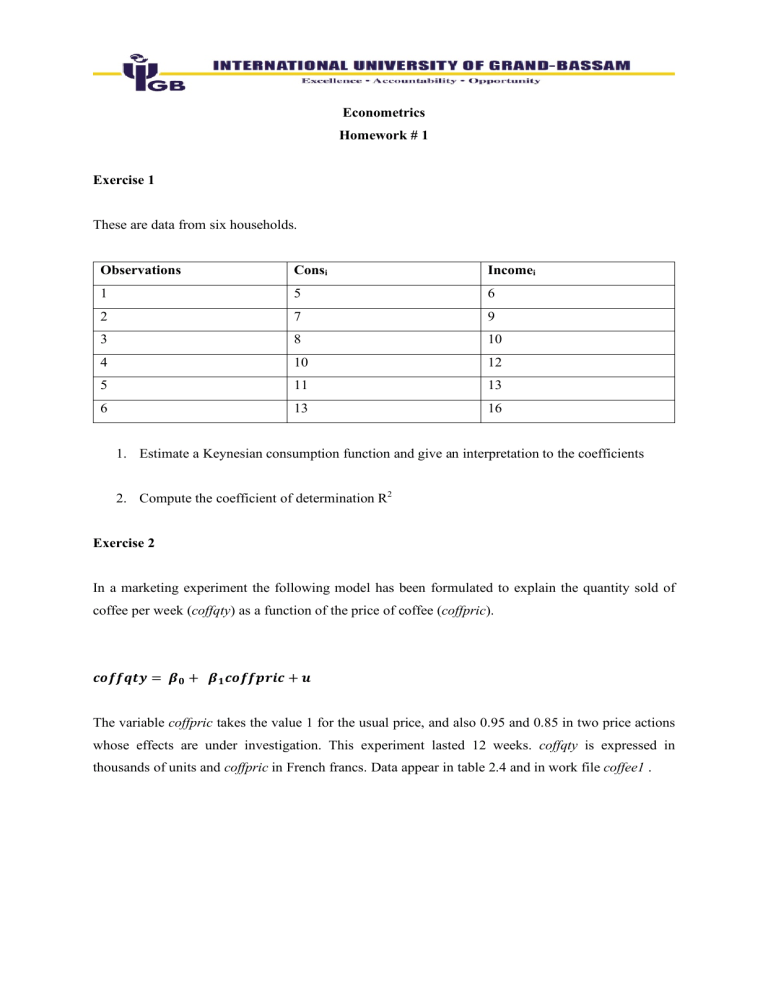
Econometrics Homework # 1 Exercise 1 These are data from six households. Observations Consi Incomei 1 5 6 2 7 9 3 8 10 4 10 12 5 11 13 6 13 16 1. Estimate a Keynesian consumption function and give an interpretation to the coefficients 2. Compute the coefficient of determination R2 Exercise 2 In a marketing experiment the following model has been formulated to explain the quantity sold of coffee per week (coffqty) as a function of the price of coffee (coffpric). 𝒄𝒐𝒇𝒇𝒒𝒕𝒚 = 𝜷𝟎 + 𝜷𝟏 𝒄𝒐𝒇𝒇𝒑𝒓𝒊𝒄 + 𝒖 The variable coffpric takes the value 1 for the usual price, and also 0.95 and 0.85 in two price actions whose effects are under investigation. This experiment lasted 12 weeks. coffqty is expressed in thousands of units and coffpric in French francs. Data appear in table 2.4 and in work file coffee1 . 1. Find the estimated value of parameters. How do you interpret the coefficients? Exercise 3 The following model has been formulated to explain the annual sales (sales) of manufacturers of household cleaning products based as a function of a relative price index (rpi): 𝑠𝑎𝑙𝑒𝑠 = 𝛽6 + 𝛽7 𝑟𝑝𝑖 + 𝑢 where the variable sales is expressed in a thousand million euros and rpi is an index obtained as the ratio between the prices of each firm and prices of the firm 1 of the sample). Thus, the value 110 in firm 2 indicates its price is 10% higher than in firm1 Data on ten manufacturers of household cleaning products are the following: a) Estimate β1 and β2 by OLS. b) Calculate the RSS. c) Calculate the coefficient of determination. d) Check that the algebraic implications 1, 3 and 4 are fulfilled in the OLS estimation. Exercise 4 An analyst formulates the following model: Are these results consistent? Explain your answer Exercise 5 The following table contains monthly housing expenditures for 10 families. (i) Find the average monthly housing expenditure. (ii) Find the median monthly housing expenditure. (iii) If monthly housing expenditures were measured in hundreds of dollars, rather than in dollars, what would be the average and median expenditures? (iv) Suppose that family number 8 increases its monthly housing expenditure to $900, but the expenditures of all other families remain the same. Compute the average and median housing expenditures. Exercise 6 Suppose the following equation describes the relationship between the average number of classes missed during a semester (missed) and the distance from school (distance, measured in miles): 𝑚𝑖𝑠𝑠𝑒𝑑 = 3 + 0.2 𝑑𝑖𝑠𝑡𝑎𝑛𝑐𝑒. (i) Draw this line, being sure to label the axes. How do you interpret the intercept in this equation? (ii) What is the average number of classes missed for someone who lives five miles away? (iii) What is the difference in the average number of classes missed for someone who lives 10 miles away and someone who lives 20 miles away? Exercise 7 Let kids denote the number of children ever born to a woman, and let educ denote years of education for the woman. A simple model relating fertility to years of education is 𝑘𝑖𝑑𝑠 = 𝛽6 + 𝛽7 𝑒𝑑𝑢𝑐 + 𝑢 where 𝑢 represents the unobserved error. (i) What kinds of factors are contained in 𝜇? Are these likely to be correlated with level of education? (ii) Will a simple regression analysis uncover the ceteris paribus effect of education on fertility? Explain.


